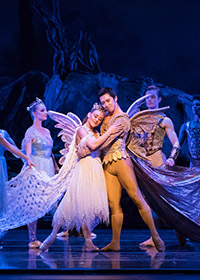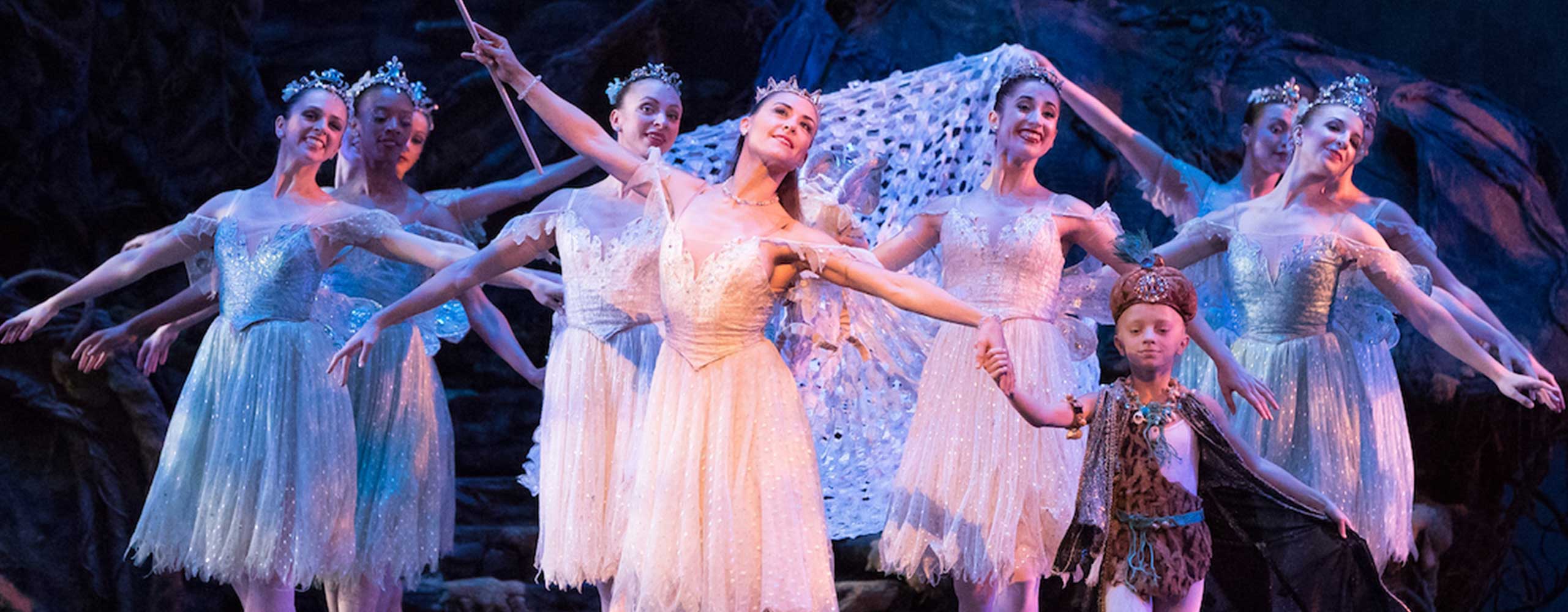
Choreography by Bruce Wells
Music by Felix Mendelssohn
Costume Design by Edward Baker
Scenic Design by Lewis Folden
Lighting Design by Trad A Burns
Synopsis
A Midsummer Night’s Dream is based on William Shakespeare’s play, a happy tangle of plots and subplots about the loves and adventures of mortals and mystical beings. For the purposes of the ballet, the story has been abbreviated, focusing largely on Titania and Oberon with fairies and wood nymphs, magical potions, and mistaken identities abounding.
In the world of mortals, Hermia and Lysander are in love. Demetrius also loves Hermia; Helena loves Demetrius. Egeus, Hermia’s father, has promised her to Demetrius. By the laws of Athens at that time, Hermia must marry Demetrius, or have her choice of becoming a nun or being put to death. To escape the law, Hermia and Lysander flee to a wood outside Athens’ gate. Helena reveals their flight to Demetrius and they follow the lovers to the wood, where the action of the ballet takes place.
Meanwhile Oberon, King of the Fairies, and Titania, his Queen, are quarreling over a child. Oberon orders Puck to bring a flower pierced by Cupid’s arrow (which causes anyone coming under its influence to fall in love with the first person the eyes behold). Oberon plans to use it to spite Titania.
Oberon is aware of the human lovers in the wood and when Puck returns with the magic flower, Oberon sends him to charm Demetrius into love with Helena. Puck accidently complicates the affairs of the mortal lovers by charming the wrong man, Lysander, into love with Helena. Oberon, trying to correct the problem, has Puck charm Demetrius into love with Helena. Helena is now loved by two men while Hermia is completely scorned and abandoned.
Meanwhile, Oberon steals into Titania’s bauer and takes the Indian boy for his own, dropping some of the flower’s juice into his Queen’s eyes. Puck, at Oberon’s orders, has separated Bottom, a weaver, from his companions, a group of actors in the woods. Puck transforms Bottom’s head into that of a donkey, and places him at the sleeping Titania’s head. Awakening, Titania sees Bottom, thinks him handsome and pays him close and loving attention.
Oberon creates a fog, and under its cover all is put right. Titania, released from her spell, is reconciled with her King and the mortals are happily paired off. Bottom is restored to human form, but with dreamlike memories of what has happened, he goes on his puzzled way.
Oberon and Titania are now reunited and at peace. A divertissement in honor of the newly married couples follows. And at last, Puck, having turned order into disorder, sweeps away the remnants of the night’s adventures.
program notes by bruce wells
A Midsummer Night’s Dream has been one of my signature pieces for the past 30 years. The Pittsburgh Press wrote “Wells’ vision of the Shakespeare comedy keenly embraces its humor, romance and fantasy.” The Post-Gazette described it as: “A ballet which took off on a gossamer wing and soared. It was truly the stuff of which dreams are made.”
My version of Midsummer is, in many ways, as it was in the original Shakespearian play — Puck as a master of ceremonies, becoming involved in and mixing up all the characters; fairies, mortals, and rustics. Many dancers have portrayed the role of Puck since Karl Condon created the role in the ballet’s 1986 World Premiere in Boston. Interestingly enough, when I staged it in Pittsburgh there was a dancer, Alex Nagiba, who was almost an exact clone of Karl. The second time Pittsburgh performed the ballet, there were so many performances that I added another Puck. Geoffrey Bullock, an African American dancer, performed the role, and it was wonderful. He portrayed the role in a very different way — less sprightly and more otherworldly. In Milwaukee, Yves DeBouteiller, a French dancer, portrayed the role and brought a very European quality to it. As the years passed, another Boston Ballet dancer, Paul Thrussell would bring his own personal impish charm to the role. Puck is important to the ballet as the catalyst for all the action, and as one of the three principals of the production. He is the bloodline, and the little piece in each of us that yearns to be magical and mystical.
Over the years I’ve added more choreography for the Rustics, tightening up and fine tuning the choreography. For example, the Rustics used to toss around books and scripts, but now they toss around Bottom instead. The children in Midsummer are always a joy, and the students of the Kansas City Ballet School are some of the most talented and charming I have ever worked with. The original choreography for the principal roles of Titania and Oberon remains the same as it was on opening night in 1986.
A Midsummer Night’s Dream has been performed by seven different companies. First Boston Ballet, where Devon Carney, now artistic director of Kansas City Ballet, originated the role of Oberon. Following were productions in Pittsburgh, Milwaukee, Detroit, Chicago, Orlando and now Kansas City. Devon set a very high bar for the dancers who would follow him, and I have always been grateful to him for his personal contribution to the creation of my vision for this production. It feels wonderful to have this full-circle moment with Devon…bringing my dream to Kansas City under his direction of the company.
Kansas City Ballet Premiere: Friday, October 7, 2016, Kauffman Center for the Performing Arts
World Premiere: Boston Ballet, February 14, 1986, Wang Theatre, Boston, Massachusetts
